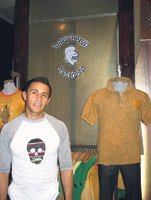East Side Story: Boutiques on Melrose's East Half Hoping for a Comeback
One of Los Angeles’s formerly leading streets for fashion and pop culture is looking to make a comeback.
Commerce has often been slow over the past four years for many retailers doing business on the east half of Melrose Avenue, between Fairfax and La Brea avenues. Many boutique owners said business has been slower than the street’s 1980s and 1990s glory days due to competition from the highly popular The Grove shopping center, which opened in 2002.
Others said that Melrose’s east side has been eclipsed by the street’s west end, which experienced a spike in high profile designers opening boutiques. Marc Jacobs, Paul Smith, Marni and Diane von Furstenberg all have opened stores on Melrose between Robertson Boulevard and Fairfax Avenue in the past two years. The Melrose Heights section of the west end also had experienced a fashion retail boom with style-setting boutiques such as Ron Herman-Fred Segal/Melrose, Xin, Creatures of Comfort, Betsey Johnson and Miss Sixty.
But Mike Andrews, a retailer who recently opened the Royal Cheapskate boutique on Melrose’s east end, said boutique owners just have to reassert their independent identity to bring the street back.
“This place is going to find its own vision. It’s going to be more cutting edge than the other side of the street,” Andrews said of the west side of Melrose.
But Andrews was warned that a rejuvenation would take time and effort. He opened the 1,000-square-foot Royal Cheapskate on Feb. 28 after quizzing Melrose retailers on the health of the street. “They gave me more horror stories than good news,” said Andrews, a former Macy’s buyer. But he said he purchased the building where his store is located, at 7260 Melrose Ave., because he thought the street would embrace new fashion.
In the case of Royal Cheapskate, change meant selling fashion that would appeal to 20- and 30ish men and women making music and film in Los Angeles’s Silverlake and Los Feliz neighborhoods.
The store’s top sellers include T-shirts from Los Angeles–based label Blood Is The New Black, $30, and accessories such as the $200 laptop computer cases from Silent Revolution, based in Long Beach, Calif.
Consumers shopping on Melrose are often looking for cheap knock-offs of fashion, said Kimiko Ikeda, manager of the 1,700-square-foot store Q-Two, located across the street from Royal Cheapskate. “People who have money go shopping on Robertson,” Ikeda said.
But she and Q-2 owner Toshimichi Aoshima have faith in the street. Aoshima moved his store from the retail district on Los Angeles’s West Third Street to Melrose in 2004 to take advantage of what he believed to be higher pedestrian traffic.
Like Andrews, he wanted to offer an alternative to streetwear and clubwear. Q-2 emphasized premium denim from brands not well known in Los Angeles, such as the Italian-based 10 Feet, retail priced at $125–$148. The store also focused on one-of-a-kind clothes such as the highly detailed T-shirts and hoodies from Los Angeles–based label Andrew Hanson’s F. The label’s retail price points range from $86 to $96.
The eastern half of the street should be due for a change because a street’s popularity runs in cycles, according to commercial real estate broker Robb Bader of Beverly Hills, Calif.–based Sachse Real Estate. “It has to be on the upswing. It’s been on the downswing for too long,” Bader said.
The average rate for a square foot of commercial real estate on the east half of Melrose is $4, and prices can climb above $5, Bader said. Rates on the more popular west side of Melrose range from $6 to $9 per square foot.
Yet the street continued to attract fashion retailers even in tough times. Ed Hardy designer Christian Audigier opened three boutiques near the corner of Melrose and Fairfax avenues in the past 18 months because he liked how the street is not just a fashion street but a street with a rock ’n’ roll culture, too. The balance is important to the fans of the tattoo-inspired fashion line, said Audigier spokesman Nathan Fuja.
Melrose’s reputation for independent design also will continue to attract consumers to the east end of the street, said Lillian Raven, owner of the boutique G.L.A.D., which opened in 2004 and sells indie labels such as English-based Bunda & Dowd and the label Raven co-designs, G.L.A.D. “Melrose still has that independent flavor,” Raven said. “People go to the malls for a certain look. They go to the street for a more fresh look. That’s what Melrose is all about.”























